The video is not accessible through Youtube due to copyright reasons, please use the following link: https://drive.google.com/file/d/1gLl5SWRypDuyZ9s94ARsaXP_XB_pL2Cn/view?usp=sharing
Script:
- Introduction
Leonie:
Echoes of the Rainbow tells the story of a typical working family in Sham Shui Po over the span of ten years from 1967 to 1977. The family consisted of Mr. and Mrs. Law and their sons, Law Chun-yat and Law Chun-yi. They lived in a small shoe shop and Mr. Law made shoes there to feed the family. In spite of living in poverty, they still had a happy, joyful, and wonderful family life. However, one day, a typhoon almost destroyed the shop and Chun-yat was diagnosed with leukemia. Although they held a positive attitude towards anything, Chun-yat still died, and so did Mr. Law years later. Chun-yi had grown from a mischievous kid with extremely poor grades to an outstanding teenager.
The film is set in 1960s British Hong Kong with some outstanding features causing by the historical and social background, which were reflected in the plots, deeply affecting the main characters. Firstly, since the establishment of New China in 1949, a great number of mainlanders emigrated to Hong Kong, including those from both the upper and working classes, which intensified social contradictions and income inequality. The British Hong Kong Government did not publish any policies to address housing problems for those working-class immigrants, so they could only build wooden houses of low quality by themselves. Meanwhile, under the regulation of the British Hong Kong Government, corruption was endemic in many fields, from the police to medical personnel. To continue with their business, merchants had no choice but to give money to the policemen periodically as protection fees. What was worse, people were generally stuck in the colonial mentality. Learning English was the only way to separate from the lower class and had become a social consensus.
So Lydia, what do you think of the features and role of framing and locations in this film?
- How and why the places are presented
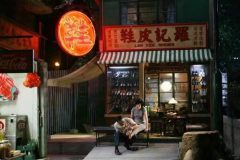
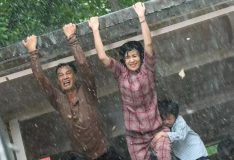
Lydia:
Though the family was set to live in Sham Shui Po, the film was shot on Wing Lee Street, playing an important role. The shoe shop, which was also the family’s home, was at one end of the street. The crude house was small in size with only two floors. The ground floor was the working place for Mr. Law, displaying all kinds of shoes made by him and the two brothers lived on the first floor, which indicates the poor living environment for the family. The brothers called the first floor “Beijing”, although they had not been there before, this clearly showed Mainland was still an attractive proposition for children of immigrants. The shop was almost destroyed by the typhoon, which not only reflected the low quality of their house, but also paved the way for introducing the biggest change in their life due to the sudden disease of the elder brother.
There were also two red signs in front of the shop, one said “LAW KEE SHOES”and the other one was a LED display with a giant Chinese character “鞋” (Shoe). Mrs. Law explained “鞋” in terms of two parts “difficulty” and “goodness”, so she always encouraged the family that one difficulty could lead to one goodness step by step. While Chun-yat was in hospital, she painted the first sign with bright red, believing they could come through all the difficulty, which reflects a positive and optimistic spirit.
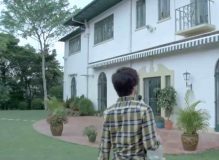
Meanwhile, the appearance of the house had a strong comparison with that of Flora’s family, which represented the upper class in Hong Kong. Her family owned a villa with a beautiful garden, and her mother could spend time playing piano without worrying about how to make a living. The contrast reminds the audience of the class differences and inequality at time. Also, the narrow bedroom for the two brothers contrasted sharply with spacious hospital room, where Chun-yat could finally stand up straight to change his clothes, leading us to further understand the family’s real living standards.
In the film, in addition to the shoe store, what other scenes play an important role?
Leonie:
In the movie, at the end of the street is a barber shop opened by his uncle. Their grandma, as an early immigrant in Hong Kong, occupied this section and asked two brothers to cut their hair and make shoes. This is just a person’s “head and tail”, which embodies Grandma’s yearning for a better life for her family in the future.
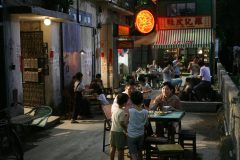
In addition to the two shops at the head and the end of the street, the most impressive scene is the place where residents eat dinner in the unit of family. In the film, this place is just a small piece of open space and stumps between shops. But it is this small area that shows the integration of small units like “family” and large units like “community”. These movie clips reflect the harmonious relationship between neighbors and depict the lively scenes in ordinary life. In addition, there are also some stories in this area. For example, in the front, other neighbors asked the elder brother Chun-yat to help read English articles, but later, Chun-yat fell ill and his father scolded him with his bad preforms in his academics. Such a seemingly ordinary scene also witnessed the development of the story.
We went on a field trip to Wing Lee Street last week. Do you have any new feelings?
- Today’s Wing Lee Street in reality
Lydia:
I was just about to mention this point.
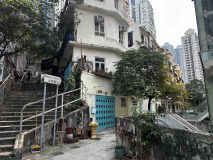
When I walked on the Wing Lee Street near Sheung Wan, I gained a deeper feeling and understanding of the shooting of this film. Wing Lee Street is located on the hillside, with long and steep stairs up and down, while Wing Lee Street is only a short street, with a row of old and short buildings on it. People enjoy the long history of Wing Lee Street, so the shops at the head and the end of the street have been converted into coffee shops. Unlike the busy streets with a strong sense of living in the movie, now Wing Lee Street has quiet old buildings compared with the surrounding skyscrapers and busy streets. It seems that this street has gone through the vicissitudes of the previous years, and now it is calm and peaceful.
- Mutual impacts of the film and the place
Lydia:
It is worth noting that, to a large extent, the architecture itself and the narrative of the film are complementary.The film relies heavily on the building itself. It is in such a street, or in a shoe store on the Wing Lee Street, that we can see the daily life and rise and fall of an average family, the “one difficult step, one good step” of this family; we witness the love between parents, the unconditional family affection of parents for 2 boys, and the tender care of brother by little brother ; at the same time, we can see the hard life of families that were from middle or low social-economic background in the 1960s and the unspeakable heartache in many cases. The film was shot on this street, so that the audience can watch the film as if they were back in that era, feeling the ups and downs and the impact of the times on the family.
Leonie:
True. And at the same time, the film also helps to a large extent the Wing Lee Street and the buildings on it. Back then, the government intended to demolish the original buildings on Wing Lee Street to improve the urban landscape. But it was the movie that triggered the nostalgia of residents in Hong Kong, which eventually allowed the building to be preserved to this day. In general, it is the film that allows us to still walk in this street today to feel the customs of that era.
Liu Kexin (Lydia) 3036098182
Xu Deming (Leonie) 3036100662
I appreciate your detailed and comprehensive discussion on the classic film — Echo of the Rainbow. Many spatial details are explored, like space Vs. social class. However, I would like to see more reflections based on lectures, readings and tutorials. Besides, I would suggest expanding your discussion through your field trip to reflect more on the destruction and reconstruction of the setting. And please consider what filmic techniques are used to capture space. Furthermore, I would suggest a more dialogue-liked podcast mode, which would greatly enhance the appeal of your work.